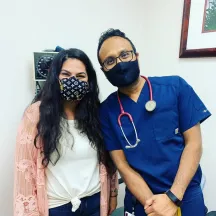
What are the differences between colon cancer and rectal cancer?

Colon cancer and rectal cancer are often grouped together because they have a lot in common — including some symptoms — but they are different, depending on where they originate. Dr. Philip Parks, Head of Medical Affairs at Exact Sciences, provides more information in this Q&A.
What is the difference between colon and rectal cancers?
The greatest difference lies is the anatomy of the body and gastrointestinal tract. While the colon and rectum are both part of the large intestine, the colon is approximately five feet long and the rectum is the last five to six inches of the colon that connects to the anus. There is a trend over the last few decades of slightly decreasing incidence in colon cancer in older individuals. However, there is a recent trend of increasing incidence of cancers of the distal colon and rectum in individuals under the age of 50. Most of these cases in younger individuals occur in people who are in their 40s and, in general, these cancers in younger individuals are more aggressive. There are common symptoms for colon and rectal cancer (bleeding, pain, changes in stool) and there are also some unique symptoms for colon and rectal cancer.
How do you diagnose colon versus rectal cancer?
While many people may be familiar with colonoscopy as a common form of screening for colon and rectal cancers, there are also non-invasive options for screening, including a stool DNA test, fecal immunochemical tests, and CT colonography. Major guidelines encourage patients and healthcare providers to select the best screening test for the patient by talking about the options. Knowing your risk factors and getting screened are the keys to diagnosing colon and rectal cancer early, when they are most treatable. If caught early, the survival rate for colorectal cancer is 90 percent—as opposed to less than 10 percent if caught in the latest stage.
Is one cancer more serious (or aggressive) than the other?
Again, anatomy plays a role. The stage of cancer—or how much the cancer has spread—is one of the most important ways to define severity. Overall, the rectum is much shorter than the colon and in a tighter spot in the body, making it potentially easier for the cancer to spread to surrounding tissue. In general, rectal cancer can be more difficult to treat and cure and may recur for as many 55 percent of people.
Are treatments for colon cancer and rectal cancer the same?
Depending on the diagnosis and progression (“stage”) of the disease, surgery and/or chemotherapy may be options to treat both colon and rectal cancers. One difference is radiation therapy, which is not commonly used to treat colon cancer; however, radiation may be used to treat rectal cancer.
What is the benefit of screening and early diagnosis?
One of the most important public health challenges is that millions of individuals are not up to date and current with colorectal cancer screening guidelines. Because of the “screening gap,” colorectal cancer is the second leading cause of cancer death in the U.S. among men and women combined, claiming more than 50,000 lives each year. The good news is that through early detection, nine out of 10 people survive—as opposed to only one in 10 if the cancer is caught in the latest stage.
Learn about colorectal cancer prevention and screening, and consider donating to the Colorectal Cancer Alliance to advance our work to advocate for screening, magnify patient support, and accelerate research.
Top resources

Colorectal cancer resources for learning and sharing
Whether personally impacted by colorectal cancer (CRC), supporting a loved one, or dedicated to educating and empowering others, these downloadable and printable resources can help.

Don Shippey: from stage IV to six years cancer-free after receiving HAI pump
Don Shippey was 55 years old in 2016 when he decided he’d been putting off his colonoscopy long enough.

Haleema Burton: Why timely screening matters even without symptoms
It’s a lot easier to prevent colorectal cancer than it is to cure it.





